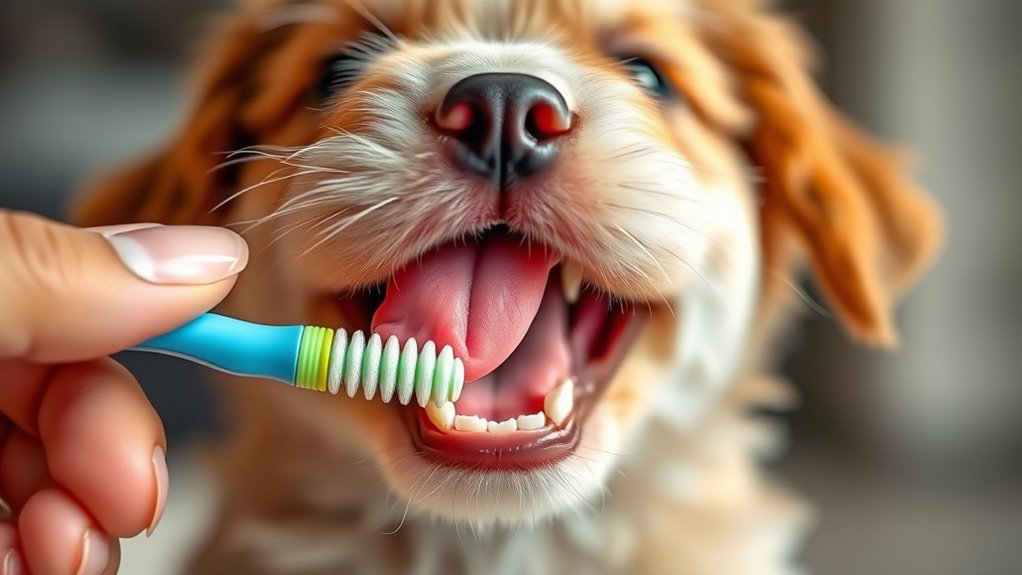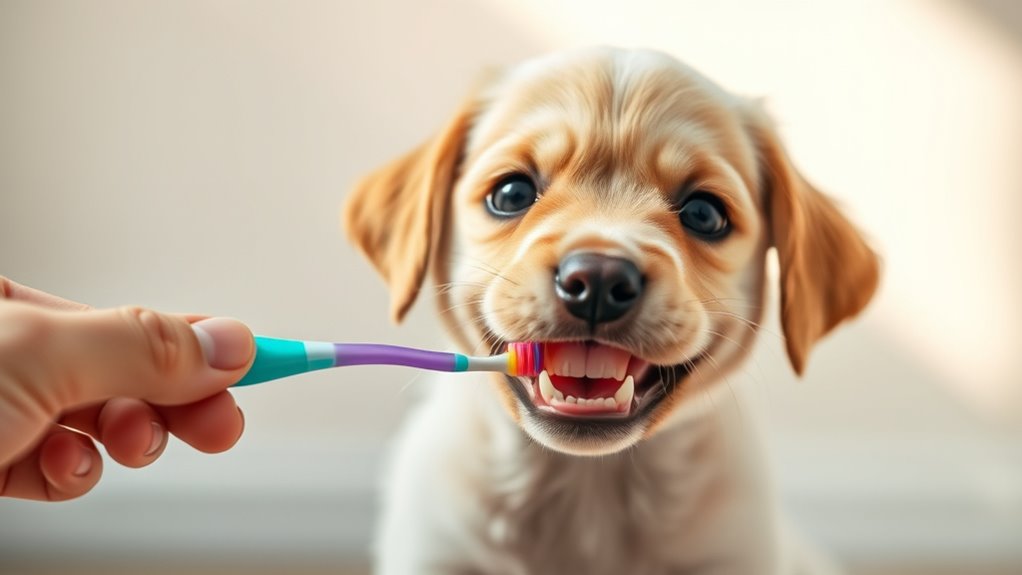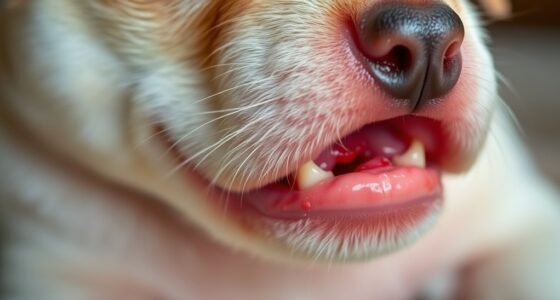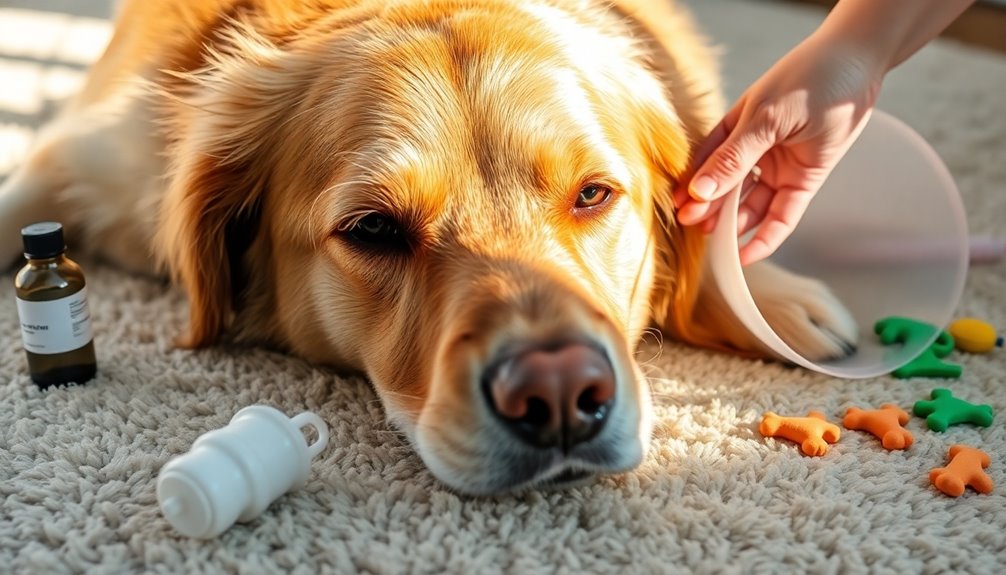To guarantee your puppy loves brushing, use gentle, steady motions with a soft-bristled toothbrush at a 45-degree angle to their gums. Make it fun by praising and rewarding them, and keep sessions short and positive. Focus on all surfaces of the teeth and don’t forget the tongue. Consistency and patience are key, and if you stay with it, you’ll discover even more simple tips to make dental care a breeze.
Key Takeaways
- Use a soft-bristled toothbrush and gentle circular motions to clean a puppy’s teeth effectively without causing harm.
- Position the brush at a 45-degree angle to the gum line for thorough plaque removal.
- Incorporate brushing all tooth surfaces, including outer, inner, and chewing surfaces, into your puppy’s routine.
- Keep sessions short and positive, using puppy-safe toothpaste to encourage acceptance and reduce stress.
- Complement brushing with regular dental chews or toys to promote healthy gums and make dental care enjoyable for puppies.

Your teeth are essential to your overall health, yet many people overlook the importance of proper dental care. Taking care of your oral hygiene isn’t just about having a bright smile; it’s about preventing cavities, gum disease, and other health issues that can stem from poor dental habits. One of the most effective ways to maintain good oral hygiene is through consistent brushing, which plays a crucial role in plaque removal. Plaque is that sticky film of bacteria that forms on your teeth every day. If left untreated, it can harden into tartar, leading to cavities and gum inflammation. That’s why understanding proper brushing techniques is vital—because the more efficiently you remove plaque, the healthier your mouth stays.
When it comes to brushing, the key is to use the right tools and techniques. Start with a soft-bristled toothbrush, which is gentle on your gums but effective at cleaning your teeth. Position your brush at a 45-degree angle to your gum line and use gentle, circular motions. This approach ensures you’re reaching beneath the gum line where plaque tends to accumulate. Make sure to brush all surfaces of your teeth: the outer, inner, and chewing surfaces. Don’t forget your tongue and the roof of your mouth; bacteria can hide there and contribute to bad breath. Brushing for at least two minutes twice a day is the standard, but many people rush through it. Take your time to be thorough—this will significantly improve plaque removal and boost your oral hygiene. Proper technique not only removes plaque more effectively but also helps prevent damage to your teeth and gums.
Additionally, using the correct brushing technique makes a big difference in preventing dental problems. Avoid aggressive scrubbing, which can damage your gums and enamel. Instead, let the bristles do the work with gentle but firm strokes. Replace your toothbrush every three to four months or sooner if the bristles fray. Worn-out brushes aren’t effective at plaque removal and can even harbor bacteria. Incorporating flossing into your routine complements brushing by cleaning between teeth where your toothbrush can’t reach, further enhancing your oral hygiene. Staying informed about emerging AI safety measures and technological advances can help you make smarter choices for your health and well-being.
Frequently Asked Questions
How Can I Tell if My Puppy’s Teeth Are Healthy?
You can tell if your puppy’s teeth are healthy by observing their gums and teeth. Look for pink, firm gums and clean, white teeth without tartar or bad odor. During the teething timeline, some discomfort is normal, but excessive redness or bleeding isn’t. Consider diet considerations that support dental health, like appropriate chew toys and nutritious food. Regular checks help make certain your puppy’s teeth stay healthy as they grow.
When Should I Start Brushing My Puppy’s Teeth?
Think of your puppy’s teeth as tiny saplings just beginning to grow; you want to nurture them early. You should start brushing around your puppy’s dental milestones, usually at 3 to 4 weeks old, to build a gentle brushing routine. Early introduction helps your pup accept teeth cleaning as a normal part of life, ensuring healthy teeth and gums as they grow.
Are There Specific Toothbrushes for Puppies?
You should definitely look for puppy-specific toothbrushes, as they’re designed to be gentle and easy for small mouths. There are various puppy toothbrush types, like finger brushes and small, soft-bristled brushes. Combining these with puppy dental toys can make brushing more fun. This approach helps establish good habits early, making dental care enjoyable for your pup and effective in preventing future dental issues.
How Often Should I Schedule Dental Check-Ups for My Puppy?
You should schedule dental check-ups for your puppy every six months to maintain good puppy oral hygiene. Regular visits help monitor their puppy dental habits, prevent dental issues, and catch problems early. Establishing routine check-ups ensures your puppy develops healthy dental habits and keeps their teeth and gums in top shape. Consistent professional care complements your at-home brushing efforts, making sure your puppy’s oral health stays ideal as they grow.
What Are Signs of Dental Problems in Puppies?
Did you know nearly 80% of dogs develop gum disease by age three? Signs of dental problems in puppies include bad breath, red or swollen gums, excessive drooling, difficulty eating, or bleeding gums. If you notice these symptoms, it’s essential to act quickly. Regular dental check-ups and proper brushing can prevent gum disease and promote healthy teeth, ensuring your puppy stays happy and comfortable.
Conclusion
Now that you’ve uncovered the secrets to puppy dental care, you’re like a skilled gardener tending to your furry friend’s brightest smile. With gentle brushing and a playful touch, you’ll nurture healthy teeth that sparkle like stars in the night sky. Remember, your effort is the magic wand that keeps cavities at bay and happiness shining through every wag. Keep up the good work, and watch your puppy’s smile blossom into a shining masterpiece!










